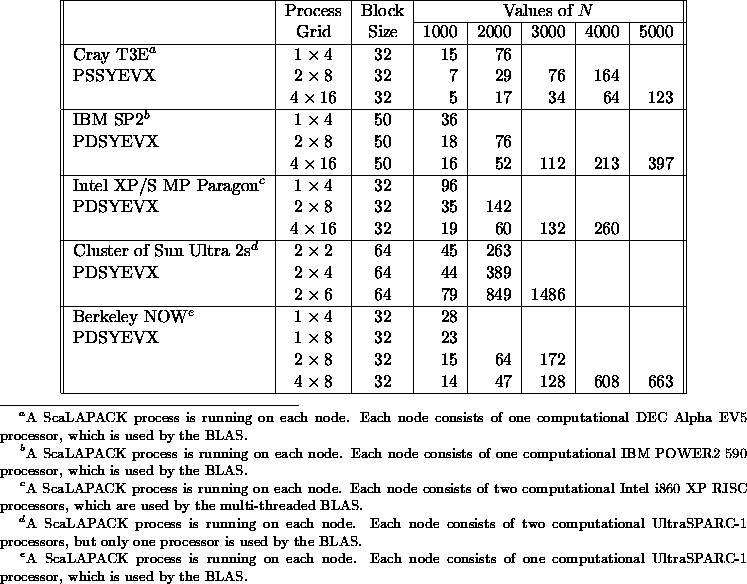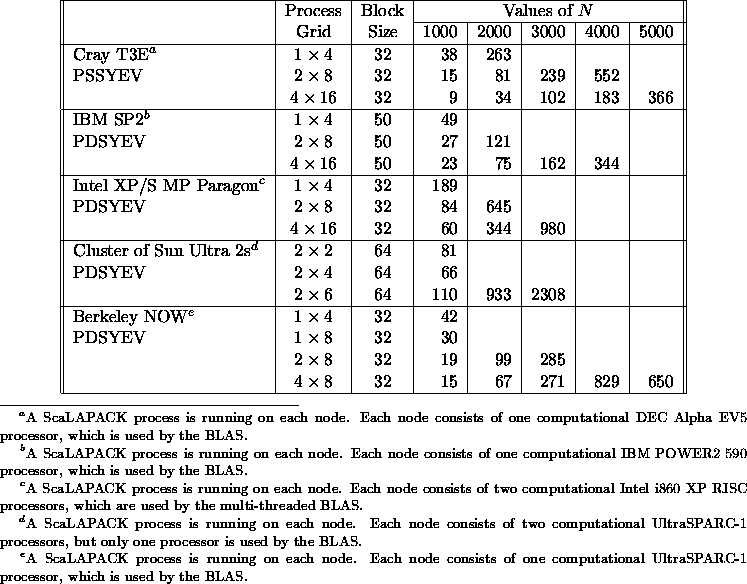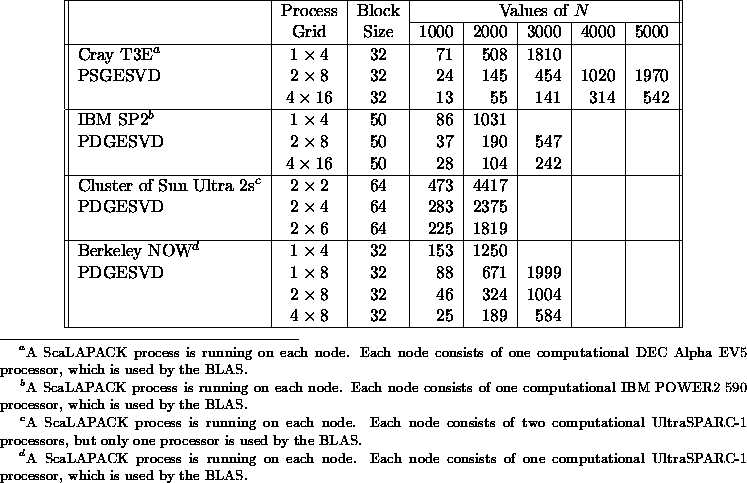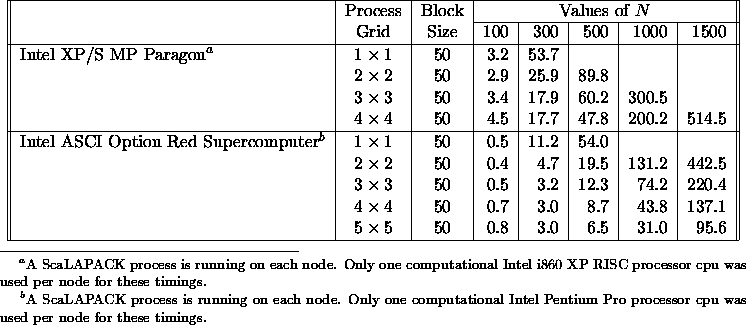




Next: Performance Evaluation
Up: Solving Linear Systems of
Previous: Solving Linear Least Squares
ScaLAPACK includes block algorithms for
solving symmetric and nonsymmetric
eigenvalue problems as well as for computing the singular value
decomposition.
The first step in solving many types of eigenvalue problems is to reduce
the original matrix to a ``condensed form'' by orthogonal
transformations.
In the reduction to condensed
forms, the unblocked algorithms
all use elementary Householder
matrices and have good vector
performance. Block forms of
these algorithms have been
developed [28],
but all require additional
operations, and a significant
proportion of the work must
still be performed by the
Level 2 PBLAS. Thus, there
is less possibility of
compensating for the extra
operations.
The algorithms concerned are listed below:
Extra work must be performed
to compute the N-by-K
matrices X and Y that
are required for the block
updates (K is the block
size), and extra workspace
is needed to store them.
Following the
reduction of
a dense symmetric matrix
to tridiagonal
form T, one
must compute the
eigenvalues and
(optionally)
eigenvectors
of T. The
current version
of ScaLAPACK
includes two
different
routines
PSSYEVX /PDSYEVX
and PSSYEV /PDSYEV
for solving symmetric
eigenproblems.
PSSYEVX/PDSYEVX
uses bisection and
inverse iteration.
PSSYEV/PDSYEV
uses the QR algorithm.
Table 5.12
and Table 5.13
show the execution time
in seconds of the routines
PSSYEVX/PDSYEVX and
PSSYEV /PDSYEV ,
respectively,
for computing the
eigenvalues and
eigenvectors of
symmetric matrices
of order N.
The performance of PSSYEVX /PDSYEVX
deteriorates in the face of large clusters of eigenvalues.
ScaLAPACK uses a nonscalable definition of clusters (because
we chose to remain consistent with LAPACK). Hence, matrices
larger than N=1000 tend to have at least one very large cluster
(see section 5.3.6). This needs further study.
More
detailed information
concerning the performance
of these routines may be
found in [40].
Table 5.14
shows the execution time
in seconds of the routines
PSGESVD /PDGESVD
for computing the
singular values and
the corresponding
right and left
singular vectors
of a general matrix
of order N.

Table 5.12: Execution time in seconds of
PSSYEVX/PDSYEVX for square
matrices of order N
For computing the eigenvalues and eigenvectors of a Hessenberg
matrix--or rather, for computing its Schur factorization--
two flavors of block algorithms have been developed. The first
algorithm implemented in the routine
PSLAHQR /PDLAHQR
results from the parallelization of the QR algorithm.
The key idea is to generate many shifts at once rather than two
at a time, thereby allowing all bulges to carry out up-to-date
shifts. The second algorithm that is currently implemented as a
prototype code
is based on the computation of the matrix sign function
[14, 13, 12].
In this section, however, only performance results of the
first approach are reported.

Table 5.13: Execution time in seconds of
PSSYEV/PDSYEV for square
matrices of order N

Table 5.14: Execution time in seconds of
PSGESVD/PDGESVD for square
matrices of order N
Table 5.15
summarizes performance results obtained for the ScaLAPACK
routine PDLAHQR doing a full Schur decomposition of an
order N upper Hessenberg matrix. The supercomputers
the table gives timings for are the Intel XP/S MP Paragon
supercomputer and technology from the Intel ASCI Option Red
Supercomputer. For both machines, we assume only one CPU
is being used for computation on this code.
The Schur decomposition is based on iteratively
applying orthogonal similarity transformations on a Hessenberg matrix
H such as

until T becomes pseudo-upper triangular (i.e., in the real case,
having one by one or two by two subdiagonal blocks.)
The serial performance (assuming roughly  flops) of the LAPACK
routine DLAHQR for computing a complex Schur decomposition is around
8.5 Mflops on the Intel MP Paragon supercomputer. The enhanced performance
shown in Table 5.15 is slightly faster, a bit above 9 Mflops,
and ends up peaking around 10 Mflops because of the block application
of Householder transforms found in the ScaLAPACK serial auxiliary
routine DLAREF. For the technology behind the Intel ASCI Option Red
Supercomputer, it peaks at several times the speed of the Paragon, and has
a slightly faster drop off in efficiency. For further details and timings,
please see [79].
flops) of the LAPACK
routine DLAHQR for computing a complex Schur decomposition is around
8.5 Mflops on the Intel MP Paragon supercomputer. The enhanced performance
shown in Table 5.15 is slightly faster, a bit above 9 Mflops,
and ends up peaking around 10 Mflops because of the block application
of Householder transforms found in the ScaLAPACK serial auxiliary
routine DLAREF. For the technology behind the Intel ASCI Option Red
Supercomputer, it peaks at several times the speed of the Paragon, and has
a slightly faster drop off in efficiency. For further details and timings,
please see [79].

Table 5.15: Execution time in seconds of
PDLAHQR for square
matrices of order N
A more detailed performance analysis of the eigensolvers
included in the ScaLAPACK software library can be found
in [48, 79].
Finally, we note that research into parallel algorithms
for symmetric and nonsymmetric eigenproblems continues
[11, 86, 45],
and future versions of ScaLAPACK will be updated
to contain the best algorithms available.





Next: Performance Evaluation
Up: Solving Linear Systems of
Previous: Solving Linear Least Squares
Susan Blackford
Tue May 13 09:21:01 EDT 1997



